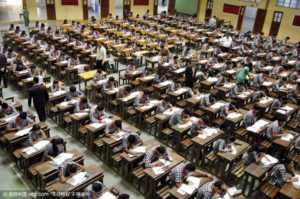
photo courtesy of Baidu
High school can be stressful academically, and in China in particular, the pressure for academic high schoolers to get accepted into university is overwhelming. While most American undergraduate colleges care about SAT and ACT scores, many also care about the holistic aspect of a student, including extracurriculars, grades, personal essays, and teacher recommendations. While the college admissions process comes with flaws, including favoring wealthier students and placing lots of stress on students, it also encourages students to pursue and develop their interests to some extent.
In China, college admission is the opposite of the holistic American admissions process. Admissions is instead based entirely on one grueling two day, nine hour test at the end of the three years of high school. The exam is the National Higher Education Entrance Examination, nicknamed “Gaokao” which means “High Test” in Chinese. Gaokao covers five different subjects — Chinese, Math, English (or another foreign language), and two arts or science subjects of choice.
The “Gaokao” is one of the hardest tests in the world. Unlike the SAT where hundreds of students annually receive perfect scores, no student has ever gotten a perfect score on the Gaokao. Gao Cai Xuan, a second year high schooler says, “I want to go to college, but getting into college is hard because you have to study a lot. There are a lot of students who study very hard.”
Not all students choose to take the Gaokao, but many do. With the exception of private international high schools, the vast majority of Chinese students are apart of the public school system. After nine years of compulsory public education, students can choose to attend either vocational or academic high school for the three years of high school, as called in China “gaozhong” or senior middle school.
Those who choose the academic route are essentially choosing a path of non-stop preparation for the Gaokao. Nine million students take the Gaokao annually, and 75 percent of those students are accepted into Chinese universities.
Achieving the score you want on Gaokao is all-consuming and competitive. After the first year of high school, vacations are few and far between, not too mention the mountains of summer homework assigned to students.
For many students, studying for the Gaokao comes at the expense of social life. While Gao Cai Xuan says that she uses Saturdays to hang out with friends or family and Sunday to study, she knows a lot of students who never go out. “I have classmates that only like to study and don’t have other hobbies because their parents want them to go to a good university,” she said.
It’s also incredibly competitive. A common scene in many Chinese movies and TV shows about high school is teachers announcing the rankings of students and discuss — in front of the class — drops in some students’ test scores.
When asked whether or not her school had class rankings, Gao Cai Xuan was surprised that was even a question. She said, “Of course we have class rankings.”
Not only is the classroom environment competitive, Gaokao scores are turned into a national competition. Until 2018, when a new federal law was enacted, top Gaokao scorers at their high schools, cities, or nationally were glorified by the local and national media.
Chinese academic high school is incredibly intense. Despite this, many praise that China’s Gaokao because it is free and thus available to all high schoolers. In the US the SAT and ACT can be pricey, with registration fees to take tests and to send scores. In China, all universities are public — and are more affordable than private American universities — as top Chinese universities cost anywhere from about 5,000 USD a year to 17,000 USD a year.
The amount of social mobility provided by attending university is immense. As the Chinese economy continues to grow, the demand for university graduates with a degree from a second or first tier university is increasing, as is the pressure for students to get admitted.
Unfortunately while the accessibility of the Gaokao should guarantee that all students have an equal shot at attending a top university, in practice it often favors wealthier students. Many academic high schoolers’ parents sacrifice everything to take care of students every chore so their students can study 24/7. Much like in the US, wealthier students also have the luxury of having expensive after-school tutoring, attending better public high schools in wealthier, urban neighborhoods, and even going to university in the United States if they don’t test well.
For Liu Chang, a current high school second year involved with extracurricular English study, organizing social events, and basketball, he prefers the American college application system. For him, he finds it unfair the Gaokao doesn’t take into consideration what he has spent his high school years doing overall.
However, in terms of college being a means of social mobility, China may even be more successful than the United States. In the past thirty years, college has been one of the predominant ways that millions of Chinese people have climbed out of poverty. Poverty has dropped from 60 percent of the population to less than three percent and as the economy continues to grow, there are more high-skilled jobs available. For many Chinese families, the sacrifices made and unbelievable pressure placed on their children to succeed on the Gaokao is well-worth it.
Despite the intensity, Gao Cai Xuan has a positive attitude. She, like Liu Chang, appreciates her teachers who try to make class interesting for her. Gao Cai Xuan isn’t upset that the final year of high school will be one non-stop Gaokao cram session. She looks forward to bonding with her classmates as they all study hard together.







